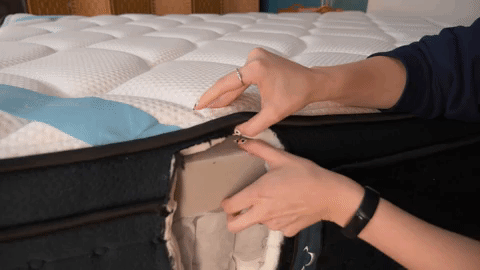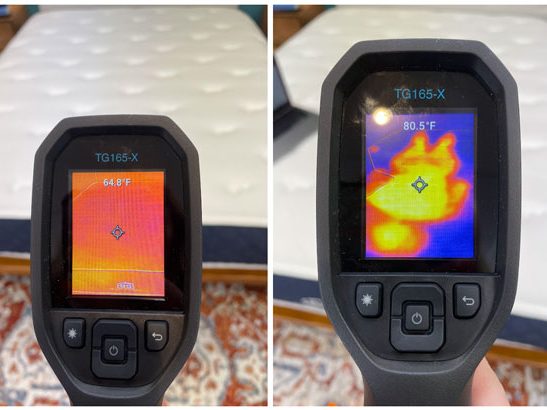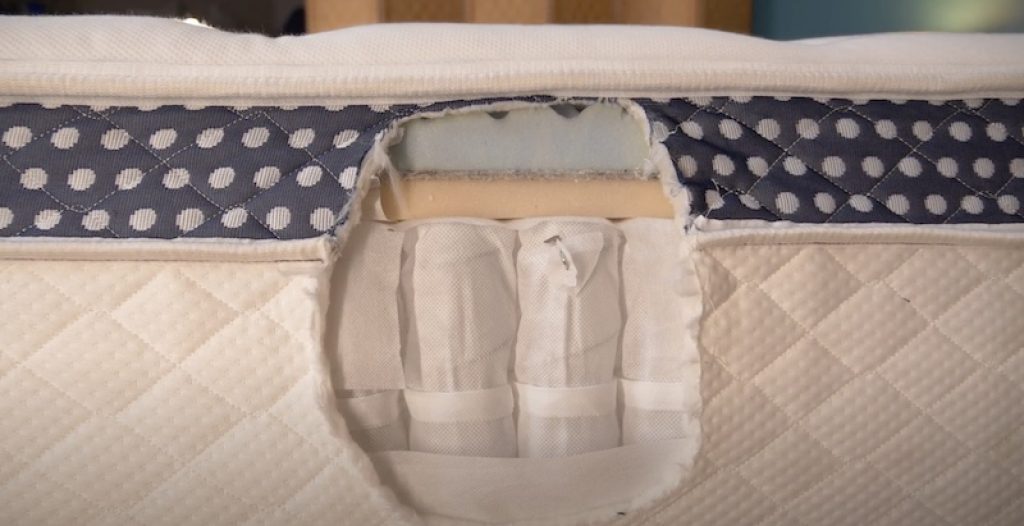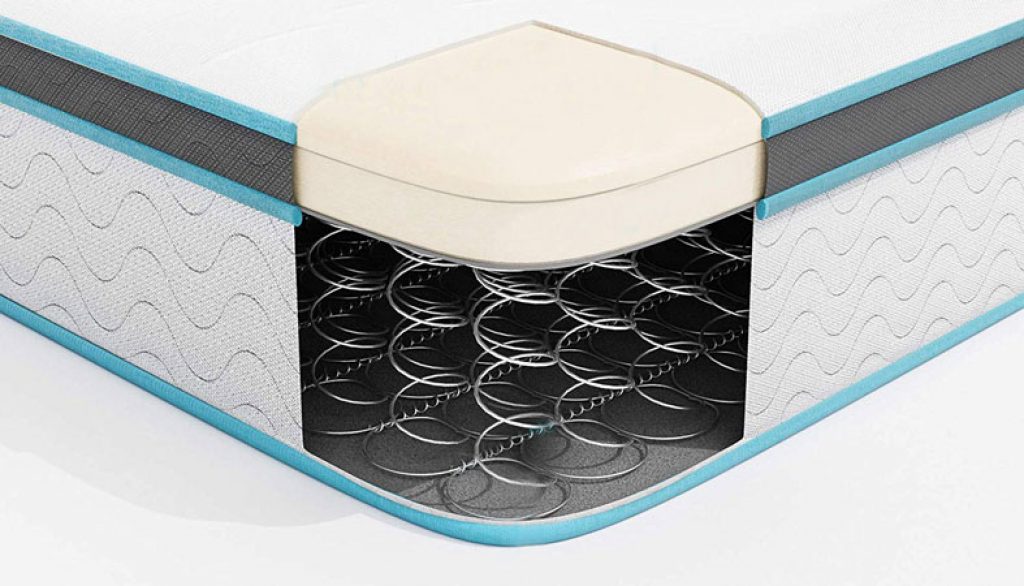You know you want a bed with coils, but you’re not sure if you should get an innerspring or a hybrid model. Perhaps you’ve used traditional innerspring beds in the past and are curious about the more innovative hybrid option, or you’ve only used all-foam models and want to change things up.
Innerspring and hybrid beds share some similarities, but there are significant differences between them that shoppers need to know. Understanding the pros and cons of each will help you in the decision-making process. We’ll walk you through the specific details of both mattress types, along with which consumers we would recommend for them.
Innerspring vs. Hybrid Mattress: Cut to The Chase
Hybrid vs. Innerspring Mattress: In-Depth Comparison
The best way to decide between these two products is to see how they stack up against each other in different categories. Depending on what you need, some categories may be more valuable to you than others.
Price
Hybrid beds are often more expensive than innerspring models due to their advanced construction and thicker profile. Hybrids have more materials in them, which results in a higher price. Plus, many models have special features like cooling gel or zoned support.
Sleeping Positions
- Side Sleepers – Side sleepers should consider a hybrid mattress because it has better comfort layers for pressure relief. Many hybrids contain memory foam, a great material pressure relief. Plus, manufacturers produce hybrids that are softer, which some side sleepers may prefer.
- Back Sleepers – Back sleepers should also like a hybrid, especially one that’s medium to medium-firm. This bed should leave your lower back nicely supported while still providing pressure relief through the foam materials.
- Stomach Sleepers – Those who like sleeping on their stomach should like both innerspring and hybrid mattresses. Both types provide sufficient pushback to prevent the midsection from sinking into the bed. However, sticking to a bed with a firmer rating is also important for these sleepers. Explore the best mattresses for stomach sleepers.
- Combination Sleepers – Combination sleepers may choose either type since they each foster good bounce. That being said, you may enjoy a hybrid more if you’re a combination sleeper who tends to sleep on your side and back only. Additionally, a lightweight combination sleeper may enjoy the extra comfort that a hybrid provides.
Body Weight
- Lightweight Sleepers (less than 130 lbs) – Lightweight sleepers will likely prefer hybrid mattresses because the extra foam layers will provide more softness. Furthermore, shoppers can opt for a hybrid mattress with a plush firmness rating for even more comfort.
- Average Weight Sleepers (130-230 lbs) – People with an average weight can pick both a hybrid and an innerspring bed. However, this is where you should also consider your sleeping position to choose the right firmness, bounce, and motion isolation.
- Heavyweight Sleepers (230+ lbs) – Heavyweight sleepers need extra support to maintain good body alignment, so it’s best to go for a hybrid mattress. Hybrids, particularly firmer ones, do well at preventing these sleepers from sinking too far into the layers. Plus, many manufacturers add dense foam layers to hybrids to further support the coils.
Firmness
We rate mattress firmness on a scale of 1 to 10, with 10 being the firmest.
Most sleepers stick to a medium-firm feel as it delivers pressure relief and support in equal parts. However, lighter sleepers typically like something more plush, while heavier individuals and stomach sleepers enjoy firmer beds.
Innersprings tend to feel firmer than hybrids because they have fewer comfort layers in them. You’ll also find more variety in firmness levels among hybrid mattresses.

Edge Support
Edge support is critical for couples and single individuals who like to spread out across the surface of the bed. Without proper edge support, you wouldn’t be able to sit or sleep near the edge of the bed. Instead, you’d feel like you’re about to roll off the bed. Hybrid mattresses usually provide better edge support because of their pocketed coils and durable foams.
Motion Isolation
Couples with different sleeping habits should always seek maximum motion isolation to achieve the best sleep. Between these two styles, hybrids are better at absorbing motion for two reasons.
First, the comfort foam layers help absorb motion, particularly if there’s memory foam present. Secondly, most hybrids use pocketed coils, which reduce motion transfer because they react independently, as opposed to the interconnected units found in innerspring beds.
Cooling Properties
Both innerspring and hybrid mattresses should be good for hot sleepers because steel coils allow plenty of airflow. However, consumers should keep in mind that hybrids have foam layers above the coil unit that are sometimes made of memory foam, which can overheat.
Luckily, most manufacturers now use gel and other measures to cool the foam layers and help hot sleepers rest comfortably.
For More Information: Best Cooling Mattresses

Coils
Both innerspring and hybrid mattresses have coils in their construction. However, hybrids have individually wrapped coils, which is rarely seen in innerspring mattresses. Therefore, although both types have coils, you should consider the coil type, count, and gauge.
- Coil Count – The number of coils in a mattress should determine its sturdiness and longevity. Queen-size hybrids usually have between 800 and 1,000 coils in a queen-size bed. Usually, a bed with more coils will be more supportive, but this is not the only factor since coil gauge also matters.
- Coil Gauge – Gauge refers to the coil thickness. The higher the gauge, the thinner the coil. Conversely, a lower gauge coil will be thicker and more supportive. Hybrids have pocket coils with the highest gauge between 14 and 18. Some models even have zoned support with higher gauge coils in the shoulder and hip area. In this case, the rest of the mattress would have lower gauge coils. Innerspring mattresses have a coil gauge between 12 and 15.
Durability
Hybrid mattresses are more durable than innerspring because the upper layers protect the coil unit. As a result, the coils are less likely to sag early or poke through. Innerspring mattresses can also last a long time with proper care and maintenance, but there is the chance of the coils pocking through the material since they don’t have as much coverage. That being said, the durability of both types depends on the quality of materials, frequency of use, and maintenance.
Find durable mattresses that won’t sag here.
Who Should Buy an Innerspring Mattress?
- Budget shoppers – Innerspring mattresses are excellent for budget-seekers interested in buying a long-lasting bed. These are affordable and can last long, even with frequent use.
- Hot sleepers – Hot sleepers should also like an innerspring mattress because of the airflow and breathability. The coil unit and thin pillow top above it should allow plenty of air to circulate, helping hot sleepers achieve better sleep.
Who Shouldn’t Buy an Innerspring Mattress?
- Couples – An innerspring mattress may not be the best option for couples. The coils are only covered by a thin pillow top, which is often not enough to isolate motion. As a result, partners may feel one another tossing and turning.
- Heavyweight sleepers – Also, heavier people might not find innerspring mattresses supportive enough, depending on the firmness level. These beds are thinner and don’t have the added support from extra foam layers.
Who Should Buy a Hybrid Mattress?
- Hot sleepers – Hot sleepers should like the breathability of a hybrid, especially if it has cooling properties like gel in the foam layers.
- Those in need of more support – The foam layers above the coil unit should provide support and comfort for all sleep positions.
- Couples – A hybrid is also a good option for couples since the foam layers will help absorb movement, and the coils are individually wrapped to reduce motion transfer.
Who Shouldn’t Buy a Hybrid Mattress?
- Budget shoppers – Hybrids feature an enhanced construction that comes with a higher price tag, which won’t make them a good match for shoppers on a tight budget. There are more affordable hybrids available, but these will still be priced higher than a traditional innerspring.
- People with limited mobility – People with limited mobility may prefer the extra bounce of an innerspring instead of a hybrid for easier repositioning. Plus, hybrids are heavier to move, so if you don’t have access to help, transporting this type of bed would be more difficult.
What Are Hybrid Mattresses?
A hybrid mattress combines coils and foam to deliver comfort and durability. The construction often includes several layers of memory foam, poly foam, or latex. The coil unit features individually wrapped steel coils that lie beneath the foam layers. Individually wrapping the coils is a technique used to minimize motion transfer that many manufacturers have adopted for their mattresses.
Many of these beds have a foam base as well, adding structure and durability and preventing the coil unit from sagging. As a result, hybrid beds are comfortable, supportive, breathable, and bouncy.

Read More: What Are Hybrid Mattresses?
What are Innerspring Mattresses?
A traditional innerspring mattress is what people often think of when we mention steel coils in a bed.
Rather than pocketed coils, innerspring beds typically have an interconnected coil unit, such as Bonell, continuous, or offset. Both Bonnell and continuous coils move as one and, therefore, cause more motion transfer. Offset coils are designed to move independently, but sleepers should still expect some motion transfer. Because of their coils, these types of mattresses provide significant support.
The comfort layer above the coils is usually wool or cotton, featuring a pillow top over, so these don’t have as much of a cushion as all-foam or hybrid models.

Read More: What Are Innerspring Mattresses?
Innerspring vs. Hybrid Mattress FAQs
What is the difference between innerspring and hybrid?
The main difference between an innerspring and a hybrid mattress is in the construction. Hybrid beds have foam layers above the coil unit. Many models also have a foam base that supports the upper layers. Innerspring mattresses only have a coil unit with a pillow top, so they’re significantly thinner than hybrids.
Are innerspring mattresses good for hot sleepers?
Innerspring mattresses are good for hot sleepers because they’re thin and don’t have as many foam layers as hybrid beds. Plus, the coils provide plenty of air circulation to cool the mattress for a more comfortable sleep.
Can you flip a hybrid mattress?
You can only flip a hybrid mattress if the manufacturer states so. Some models are made with a dual-sided design to provide different firmness levels. A double sided mattress allows you to choose between two firmness levels while also increasing the longevity of your bed since you get to use both sides.
Final Word of Advice
Now that you know more about innerspring and hybrid mattresses, you probably have an idea of which type would fit you best. Each bed has unique properties, advantages, and disadvantages. However, you should always consider your individual needs, sleeping position, budget, and body weight when deciding between innerspring and hybrid beds.
The Advisor Says
Once you figure out which of the two is more suitable for your needs, you can focus more on finding the right model among some of our favorites.

Jill Zwarensteyn
Senior Editor
About Author
Jill Zwarensteyn is the senior editor for Sleep Advisor and a certified sleep science coach. She is enthusiastic about providing helpful and engaging information on all things sleep and wellness.
Combination Sleeper